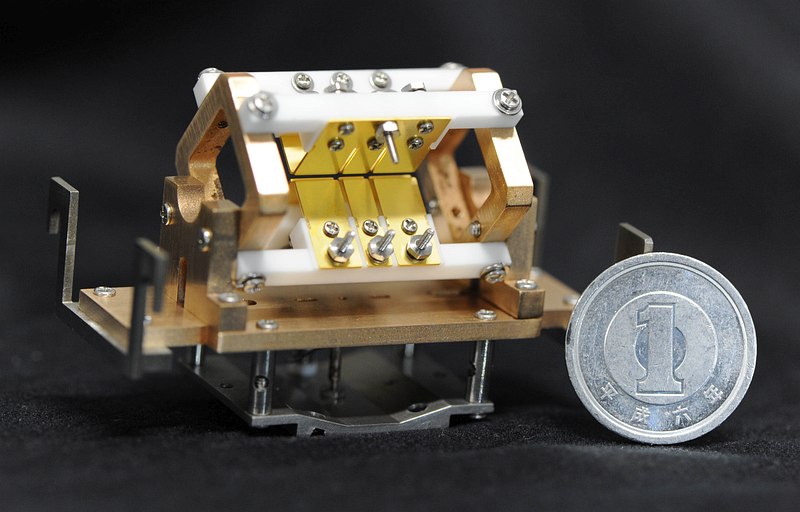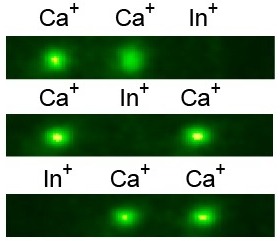Development of In⁺ ion optical frequency standard
Ion optical frequency standards probe quantum transitions in the optical frequency domain of ions captured in an electric field to realize a highly accurate frequency reference. We are performing frequency measurements of the narrow clock transition of the indium ion (In⁺), with the goal of realizing a robust and precise optical frequency standard.

In an ion trap, a rapidly oscillating electric field is used to capture individual ions at the point of minimal electric field. This is ideal for performing frequency measurements without the effects of ion motion or collisions. The require equipment is generally smaller than what is needed for an optical lattice frequency standard working with neutral atoms, making it suitable for the development of compact and portable devices.
The indium ion has an alkaline earth-like electron configuration, and the state of the ion can be directly probed with a laser in the ultraviolet part of the optical spectrum. This makes the indium ion clock easier to implement and operate than clocks based on other alkaline earth-like ions such as aluminum.

The clock transition in In⁺ is insensitive to frequency shifts from external fields, not only from the trap itself, but also nearby other ions. Besides enabling more accurate measurements, this also makes indium a promising candidate for a multi-ion optical frequency standard, a next generation approach that will allow ion clocks to perform frequency measurements in a shorter amount of time. We already use this insensitivity to nearby ions by trapping calcium ions in the same trap to help cool the indium ion to ultra-cold temperatures.
In 2017 NICT performed a highly accurate measurement of the In⁺ clock frequency. The result helped revise the recommendation of the International Committee for Weights and Measures (CIPM) for the absolute frequency value to apply when using an In⁺ frequency standard. We also demonstrated a direct frequency comparison measurement between an In⁺ ion clock and the Sr optical lattice clock in 2020. Such direct measurements can demonstrate the performance of optical clocks beyond the limitations of the current cesium frequency standards.
Publications
1)
N. Ohtsubo, Y. Li, N. Nemitz, H. Hachisu, K. Matsubara, T. Ido, K. Hayasaka,
Frequency ratio of an ¹¹⁵In⁺ ion clock and a ⁸⁷Sr optical lattice clock,
Opt. Lett. 45, 5950 (2020)
(2020)
2)
N. Ohtsubo, Y. Li, N. Nemitz, H. Hachisu, K. Matsubara, T. Ido, K. Hayasaka,
Optical clock based on a sympathetically-cooled indium ion,
Hyperfine Interact. 240, 39 (2019)
(2019)
3)
N. Ohtsubo, Y. Li, K. Matsubara, T. Ido, K. Hayasaka,
Frequency measurement of the clock transition of an indium ion sympathetically-cooled in a linear trap,
Opt. Express 25, 11725 (2017)
(2017)
4)
K. Wakui, K. Hayasaka, T. Ido,
Generation of vacuum ultraviolet radiation by intracavity high-harmonic generation toward state detection of single trapped ions,
Appl. Phys. B 117, 957 (2014)
(2014)
5)
K. Hayasaka,
Synthesis of two-species ion chains for a new optical frequency standard with an indium ion,
Appl. Phys. B 107, 965 (2012)
(2012)

